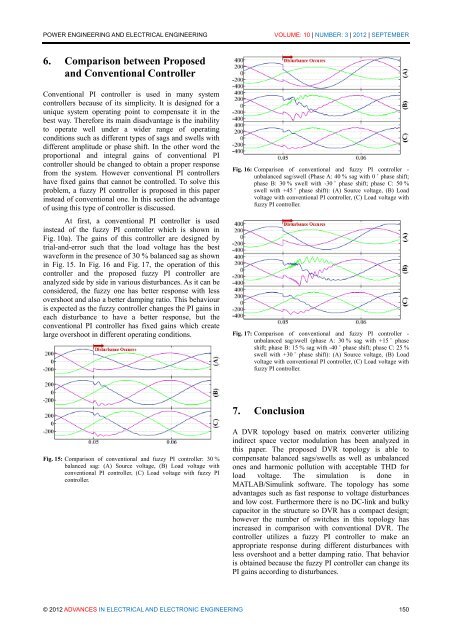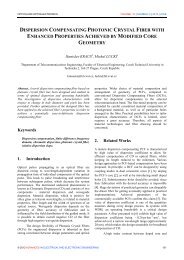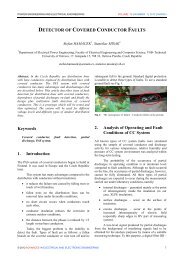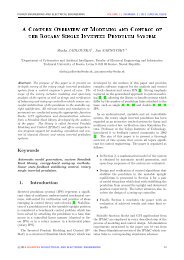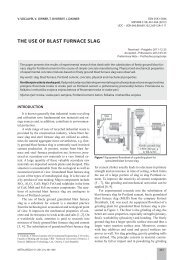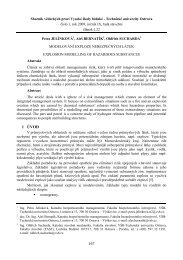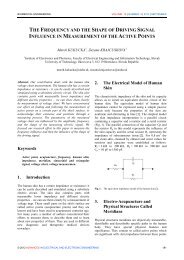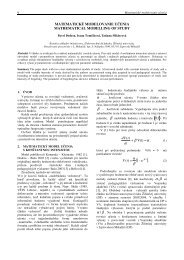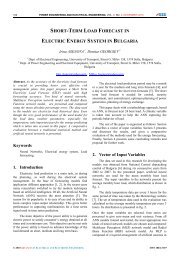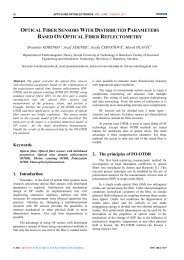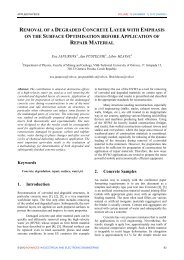A Dynamic Voltage Restorer based on Matrix Converter with Fuzzy ...
A Dynamic Voltage Restorer based on Matrix Converter with Fuzzy ...
A Dynamic Voltage Restorer based on Matrix Converter with Fuzzy ...
You also want an ePaper? Increase the reach of your titles
YUMPU automatically turns print PDFs into web optimized ePapers that Google loves.
POWER ENGINEERING AND ELECTRICAL ENGINEERING<br />
VOLUME: 10 | NUMBER: 3 | 2012 | SEPTEMBER<br />
6. Comparis<strong>on</strong> between Proposed<br />
and C<strong>on</strong>venti<strong>on</strong>al C<strong>on</strong>troller<br />
C<strong>on</strong>venti<strong>on</strong>al PI c<strong>on</strong>troller is used in many system<br />
c<strong>on</strong>trollers because of its simplicity. It is designed for a<br />
unique system operating point to compensate it in the<br />
best way. Therefore its main disadvantage is the inability<br />
to operate well under a wider range of operating<br />
c<strong>on</strong>diti<strong>on</strong>s such as different types of sags and swells <strong>with</strong><br />
different amplitude or phase shift. In the other word the<br />
proporti<strong>on</strong>al and integral gains of c<strong>on</strong>venti<strong>on</strong>al PI<br />
c<strong>on</strong>troller should be changed to obtain a proper resp<strong>on</strong>se<br />
from the system. However c<strong>on</strong>venti<strong>on</strong>al PI c<strong>on</strong>trollers<br />
have fixed gains that cannot be c<strong>on</strong>trolled. To solve this<br />
problem, a fuzzy PI c<strong>on</strong>troller is proposed in this paper<br />
instead of c<strong>on</strong>venti<strong>on</strong>al <strong>on</strong>e. In this secti<strong>on</strong> the advantage<br />
of using this type of c<strong>on</strong>troller is discussed.<br />
At first, a c<strong>on</strong>venti<strong>on</strong>al PI c<strong>on</strong>troller is used<br />
instead of the fuzzy PI c<strong>on</strong>troller which is shown in<br />
Fig. 10a). The gains of this c<strong>on</strong>troller are designed by<br />
trial-and-error such that the load voltage has the best<br />
waveform in the presence of 30 % balanced sag as shown<br />
in Fig. 15. In Fig. 16 and Fig. 17, the operati<strong>on</strong> of this<br />
c<strong>on</strong>troller and the proposed fuzzy PI c<strong>on</strong>troller are<br />
analyzed side by side in various disturbances. As it can be<br />
c<strong>on</strong>sidered, the fuzzy <strong>on</strong>e has better resp<strong>on</strong>se <strong>with</strong> less<br />
overshoot and also a better damping ratio. This behaviour<br />
is expected as the fuzzy c<strong>on</strong>troller changes the PI gains in<br />
each disturbance to have a better resp<strong>on</strong>se, but the<br />
c<strong>on</strong>venti<strong>on</strong>al PI c<strong>on</strong>troller has fixed gains which create<br />
large overshoot in different operating c<strong>on</strong>diti<strong>on</strong>s.<br />
Fig. 16: Comparis<strong>on</strong> of c<strong>on</strong>venti<strong>on</strong>al and fuzzy PI c<strong>on</strong>troller -<br />
unbalanced sag/swell (Phase A: 40 % sag <strong>with</strong> 0 ˚ phase shift;<br />
phase B: 30 % swell <strong>with</strong> -30 ˚ phase shift; phase C: 50 %<br />
swell <strong>with</strong> +45 ˚ phase shift): (A) Source voltage, (B) Load<br />
voltage <strong>with</strong> c<strong>on</strong>venti<strong>on</strong>al PI c<strong>on</strong>troller, (C) Load voltage <strong>with</strong><br />
fuzzy PI c<strong>on</strong>troller.<br />
Fig. 17: Comparis<strong>on</strong> of c<strong>on</strong>venti<strong>on</strong>al and fuzzy PI c<strong>on</strong>troller -<br />
unbalanced sag/swell (phase A: 30 % sag <strong>with</strong> +15 ˚ phase<br />
shift; phase B: 15 % sag <strong>with</strong> -40 ˚ phase shift; phase C: 25 %<br />
swell <strong>with</strong> +30 ˚ phase shift): (A) Source voltage, (B) Load<br />
voltage <strong>with</strong> c<strong>on</strong>venti<strong>on</strong>al PI c<strong>on</strong>troller, (C) Load voltage <strong>with</strong><br />
fuzzy PI c<strong>on</strong>troller.<br />
7. C<strong>on</strong>clusi<strong>on</strong><br />
Fig. 15: Comparis<strong>on</strong> of c<strong>on</strong>venti<strong>on</strong>al and fuzzy PI c<strong>on</strong>troller: 30 %<br />
balanced sag: (A) Source voltage, (B) Load voltage <strong>with</strong><br />
c<strong>on</strong>venti<strong>on</strong>al PI c<strong>on</strong>troller, (C) Load voltage <strong>with</strong> fuzzy PI<br />
c<strong>on</strong>troller.<br />
A DVR topology <str<strong>on</strong>g>based</str<strong>on</strong>g> <strong>on</strong> matrix c<strong>on</strong>verter utilizing<br />
indirect space vector modulati<strong>on</strong> has been analyzed in<br />
this paper. The proposed DVR topology is able to<br />
compensate balanced sags/swells as well as unbalanced<br />
<strong>on</strong>es and harm<strong>on</strong>ic polluti<strong>on</strong> <strong>with</strong> acceptable THD for<br />
load voltage. The simulati<strong>on</strong> is d<strong>on</strong>e in<br />
MATLAB/Simulink software. The topology has some<br />
advantages such as fast resp<strong>on</strong>se to voltage disturbances<br />
and low cost. Furthermore there is no DC-link and bulky<br />
capacitor in the structure so DVR has a compact design;<br />
however the number of switches in this topology has<br />
increased in comparis<strong>on</strong> <strong>with</strong> c<strong>on</strong>venti<strong>on</strong>al DVR. The<br />
c<strong>on</strong>troller utilizes a fuzzy PI c<strong>on</strong>troller to make an<br />
appropriate resp<strong>on</strong>se during different disturbances <strong>with</strong><br />
less overshoot and a better damping ratio. That behavior<br />
is obtained because the fuzzy PI c<strong>on</strong>troller can change its<br />
PI gains according to disturbances.<br />
© 2012 ADVANCES IN ELECTRICAL AND ELECTRONIC ENGINEERING 150


